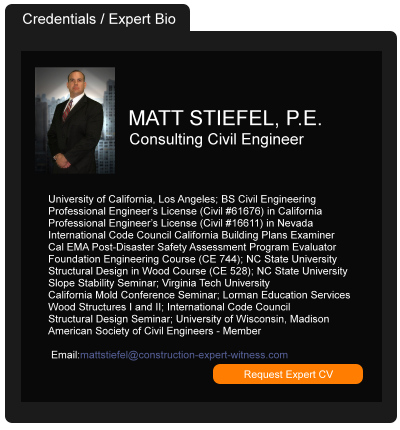Emerging Trends in Shortened Statutes of Limitations and Statutes of Repose
January 02, 2024 —
Ivette Kincaid & Thomas McCarrick - Kahana FeldIntroduction
A growing trend in construction defect legislation around the country has seen the shortening of statutes of limitation and statutes of repose for a plaintiff to bring claims related to construction defects. Over the past ten years, several states, notably Florida and Texas, have shortened their statutes of repose. This is generally positive news for developers and contractors; however, the specifics and ramifications of these legislative and judicial updates are still unknown.
Statute of Limitations
A statute of limitations sets forth the time that a plaintiff has to sue or allege a particular cause of action against a defendant. These time limitations are codified into law and vary depending on the State and the cause of action. A statute of limitations starts at the occurrence of an injury or damage or at the time the injury or damage is discovered. The statute of limitations may be subject to some exceptions such as tolling for reasons such as the injured party being a minor in which case depending on the particular statute, the statute does not begin to run until after the minor reaches the age of majority.
Reprinted courtesy of
Ivette Kincaid, Kahana Feld and
Thomas McCarrick, Kahana Feld
Ms. Kincaid may be contacted at ikincaid@kahanafeld.com
Mr. McCarrick may be contacted at tmccarrick@kahanafeld.com
Read the court decisionRead the full story...Reprinted courtesy of
Construction Defects Lead to Demolition of Seattle’s 25-story McGuire Apartments Building
March 16, 2011 —
CDJ STAFFAccording to a story published last Thursday in Seattle PI: " The 25-story McGuire Apartments, at Second Avenue and Wall Street, would cost more to fix than the building is worth, according to its owners. Its most serious defect involves steel cables that are corroding inside of concrete slabs because the ends weren’t properly treated with a rust-proof coating and a pocket in the edge of the concrete that wasn’t properly sealed"
�The report by Aubrey Cohen outlines the demolition plans which are expected to take between 12 and 18 months, and will utilize robotic Brokk Machines. The demolition plan calls for one story at a time to be demolished, with the debris to be trucked offsite. Demolition plans aim to minimize disruption to residents and businesses in the area by Limiting work 7 a.m. to 6 p.m. on weekdays and 9 a.m. to 6 p.m. Saturdays with "impact and percussive activities" limited to 8 a.m to 5 p.m weekdays.
�Read More...
Read the court decisionRead the full story...Reprinted courtesy of
West Coast Casualty Promises Exciting Line Up at the Nineteenth Annual Conference
March 28, 2012 —
CDJ STAFFWest Coast Casualty has announced the lineup for the annual WCC Construction Defect Seminar. This year’s seminar will be the nineteenth anniversary, and it will be held on May 17th and 18th, 2012 in Anaheim, California. They are the largest construction defect event in the world and this year’s seminar will again bring the top people in the field to address many of the current issues and where the construction defect community will be going in the future.
�The event, anticipated to be even larger than prior years, will have numerous panels and presentations on the current state of construction defect litigation. Among the topics that will be presented are “Arbitrate? Let’s See You Make Me!” “Defending Construction Defect Failure Mechanisms?An Expert’s Perspective,” and “Current Trends in Effectively Handling SB800 Cases.”
�Speakers at the event will include judges, lawyers, and representatives of the insurance industry. One event, “Meet Your Judges, A Candid Discussion on Construction Defect Claims and Litigation from the Bench?” will include judges from five states, including the Honorable Nancy M. Saitta, Chief Justice of the Nevada Supreme Court, the Honorable Clifton Newman of the South Carolina Circuit Court, and the Honorable Rex Heeseman of the Los Angeles County Superior Court.
�Daniel A. Berman, Esq. and Stephen Henning, Esq. will be talking on the topic of “Social Networking Sites: Strategies, Ethical Pitfalls, and Practice Pointers for Litigating and Winning Your Construction Defect Case.” Mr. Berman is a Founding and Managing Partner of Wood, Smith, Henning & Berman LLP. He has been named a Southern California Super Lawyer for eight consecutive years. Mr. Henning is a Founding Partner of Wood, Smith, Henning & Berman, LLP and Fellow of the Litigation Counsel of America. Mr. Henning will also be one of the presenters on the panel “Important Court Decisions Impacting Construction Defect Claims.”
�The panel “Why Do We Need to Know Certain Things and How Decisions Are Made” will be presented by important figures in the construction claims industry, including Phyllis Modlin, Todd Schweitzer, Teresa D. Wolcott, and Lee Wright. Ms. Modlin is a Construction Defect Claims Supervisor responsible for nationwide claims for Markel Corporation. Mr. Schweitzer is an Assistant Vice President of Major Case for Construction Defect and Professional Liability Claims Services at Zurich North America. Ms. Wolcott is the National Product Manager for Construction Defect Claims within the Construction Claims Organization at Travelers Insurance. Mr. Wright is an Assistant Vice President and Senior Claims Consultant for XL Specialty Insurance.
�The event will also include a Science and Technology Fair in which exhibitors will be presenting technological problem solving and decision making as they relate to resolving ongoing construction and post construction-defect related issues while reducing costs for all those involved in claims and litigation. The fair is dedicated to these novel applications of science and technology that benefit the construction defect community but are not yet commonly available. This will be the third time the Construction Defect Seminar will include a Science and Technology Fair.
�Sessions at the event are approved for MCLE credit in Arizona, California, Colorado, Illinois, Maine, Minnesota, New York, Ohio, and Pennsylvania. MCLE credits vary by state; attendees can obtain up to 10.25 hours of credit in Arizona, California, Maine, and New York. Applications for several other states are still pending. Additionally, the event is also worth continuing education credits with the Florida Department of Insurance and for Registered Professional Adjusters. West Coast Casualty has applications pending for adjuster continuing education in an additional thirty-six states.
�West Coast Casualty recommends this event for anyone involved in construction or construction defect claims, whether they are a claims adjuster, a member of a homeowner board, a judge, a property manager, a construction claims attorney, a general contractor, or anyone else with an interest in this area. The event typically has more than 1,600 attendees. Those interested can register online.
Read the full story…
Read the court decisionRead the full story...Reprinted courtesy of
Florida Law: Interplay of SIR and the Made-Whole Doctrine
March 12, 2015 —
Beverley BevenFlorez-CDJ STAFFAmanda Baggett of Roger Towers explained the nuances of self-insured retention or “SIR,” which “typically refers to a dollar amount stated in a liability policy that the insured must satisfy before the insurer is required to defend or indemnify a claim.” Baggett stated that most of the time, the SIR is satisfied by the insurer paying the initial defense costs up to the SIR. However, “the Florida Supreme Court has held that an insured may satisfy the SIR using funds received from a third party. Intervest Construction of Jax, Inc. v. General Fidelity Ins. Co., 133 So. 3d 494 (Fla. 2014).”
Read the court decisionRead the full story...Reprinted courtesy of
Rhode Island District Court Dismisses Plaintiff’s Case for Spoliation Due to Potential Unfair Prejudice to Defendant
September 04, 2018 —
Lian Skaf - The Subrogation StrategistIn Amica Mutual Ins. Co. v. BrassCraft Mfg., Co., 2018 U.S. Dist. LEXIS 88986 (D.R.I. May 29, 2018), the United States District Court for the District of Rhode Island addressed the question of whether the defendant was so unfairly prejudiced by the subrogating insurer’s spoliation of evidence that dismissal of the plaintiff’s case was the appropriate Rule 37(b)(2)(a)(i)-(vi) sanction. The court, focusing on the potential for undue prejudice to the defendant, granted the defendant’s motion to dismiss.
Read the court decisionRead the full story...Reprinted courtesy of
Lian Skaf, White and Williams, LLPMr. Skaf may be contacted at
skafl@whiteandwilliams.com
Jason Smith and Teddie Arnold Co-Author Updated “United States – Construction” Chapter in 2024 Legal 500: Country Comparative Guides
May 28, 2024 —
Jason Smith & Edward (Teddie) Arnold - The Construction SeytJason Smith and
Teddie Arnold, partners in Seyfarth’s Washington, DC office, have co-authored an updated “United States – Construction” chapter in the 2024 edition of The Legal 500: Country Comparative Guides. Seyfarth continues to participate as an exclusive contributor for this comprehensive overview of construction-specific laws and regulations in the United States. Topics covered include, but are not limited to, requirements and obligations, permits and licencing, procurement, financing and security, and disputes, as well as insight and opinion on current challenges and opportunities. To access and download a copy of the chapter, click
here.
Reprinted courtesy of
Jason N. Smith, Seyfarth and
Edward V. Arnold, Seyfarth
Mr. Smith may be contacted at jnsmith@seyfarth.com
Mr. Arnold may be contacted at earnold@seyfarth.com
Read the full story... Read the court decisionRead the full story...Reprinted courtesy of
Guilty Pleas Draw Renewed Interest In Nevada’s Construction Defect Laws
December 09, 2011 —
CDJ STAFFA report this week by David McGrath Schwarz of the Las Vegas Sun suggests that Nevada’s construction defect laws will be a point of much contention in upcoming legislative sessions. The report cites renewed interest in the state’s construction defect laws due to ongoing federal investigations of construction defect attorney Nancy Quon and construction company owner Leon Benzer. Guilty pleas have been entered by at least ten individuals including an attorney, property managers, straw purchasers, and former HOA board members.
The article suggests that Nevada’s Chapter 40 laws are easily manipulated to the detriment of Nevada’s homebuilding industry. Construction industry lobbyists have tried unsuccessfully to change the laws in past legislative sessions.
The Sun’s article speculates that the building industry might be able to gain legislative concessions due to the volume of guilty pleas and what it refers to as examples of Chapter 40 abuses. ”With federal authorities collecting guilty pleas, the construction industry has prime examples of the system being abused, and how lucrative it can be for attorneys.”
Read the full story…
Read the court decisionRead the full story...Reprinted courtesy of
New York Construction Practice Team Obtains Summary Judgment and Dismissal of Labor Law Claims
October 01, 2024 —
Lewis Brisbois NewsroomNew York, N.Y. (August 23, 2024) – In Trujillo-Cruz v. City of New York, et al., New York Partner Inderjit Dhami, a member of New York Partner Meghan A. Cavalieri’s Construction Practice Team, recently obtained summary judgment and dismissal of the plaintiff's Labor Law §240(1), §241(6) and §200 claims dismissing the entire case against national developer and construction company clients.
The plaintiff alleged to have sustained injuries as the result of a construction site accident occurring on July 11, 2018, while in the scope of his employment as a laborer in connection with the construction/renovation of a residential apartment building in Brooklyn, New York. Specifically, the plaintiff alleged that he was injured when he was coming down from a ladder and fell on a 2”x 4”, causing him disabling injuries. The plaintiffs’ counsel articulated a $3 million settlement demand.
Labor Law §240(1) imposes absolute liability on a defendant where an injured worker engaged in the performance of covered construction work establishes that a safety device proved inadequate to shield him from elevation-related harm, and that the defendant’s failure to provide an adequate safety device proximately caused the injuries alleged. The plaintiff first testified that he stepped on the 2” x 4” after he came down off of the ladder, but his counsel then prompted him to recalibrate his testimony by asking whether the accident arose when he was coming down the ladder or after he had come down off of the ladder. The plaintiff changed his testimony, alleging that the accident arose as he was coming down the ladder and that he remained partially on the ladder when he stepped on the piece of formwork and fell. Inderjit argued that the plaintiff’s reframing of his deposition testimony was immaterial for purposes of the Labor Law § 240 (1) analysis. Irrespective of whether the plaintiff was on solid ground or had one foot on the ladder at the time of the occurrence, his Labor Law § 240 (1) claim was unavailing in that the accident did not arise as a result of the type of extraordinary elevation-related peril protected by Labor Law § 240 (1). Justice Maslow agreed and dismissed the plaintiff’s Labor Law § 240 (1) claims.
Read the court decisionRead the full story...Reprinted courtesy of
Lewis Brisbois


































































